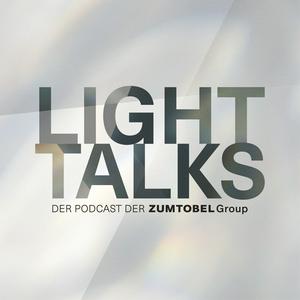#29 Shedding Light on Architecture and Art as a Tool for Change – with Anna Heringer and Otobong Nkanga
In Folge 29 von Light Talks waren die deutsche Architektin Anna Heringer und die nigerianische bildende und Performance-Künstlerin Otobong Nkanga, die heute in Antwerpen lebt und arbeitet, zu Gast bei Natalie Kreutzer, Editor-in-Chief der Zumtobel Group. Beide habe zahlreiche renommierte Auszeichnungen gewonnen, jedoch geht es ihnen nicht um Prestige; beiden ist soziales Engagement extrem wichtig und beide sind fasziniert von der Schönheit des Materials Lehm. Anna Heringer – die sich selbst eher als Aktivistin bezeichnet denn als Architektin – hat den diesjährigen Geschäftsbericht der Zumtobel Group mit dem Titel „Licht – die natürliche Kraft, die Dinge sichtbar macht“ gestaltet. Das Gespräch ist von ihrem Buch inspiriert, das mit der Frage: „Wer soll davon profitieren, wer gestärkt werden?” begann, und von der kürzlich eröffneten kontextuellen Ausstellung im Dornbirner Lichtforum der Zumtobel Group. Wir gewinnen sehr persönliche Einblicke in die Arbeit der beiden Gäste und in ihre Gedankenwelt: Was bringen wir in die Welt? Wie werfen wir Licht auf andere Menschen, auf die Materialien, die wir verwenden? Die Erde. Wie schaffen wir eine Gemeinschaft? Wie denken wir Wirtschaft? Und wie können wir positives Licht für die Zukunft sehen?Die beiden Gäste verraten, wie sie mit ihrer Arbeit Bewusstsein schaffen und Veränderungen inspirieren wollen. Anna Heringer ist Co-Initiatorin von Dipdii Textiles, einer Frauenkooperative für faire Mode und Textilkunst in Bangladesch, eines Projekts, das ihr sehr am Herzen liegt und dessen Gründung auf ein verbranntes Shirt zurückgeht. Otobong Nkanga schafft seit den späten 1990er-Jahren ausdrucksvolle und visuell eindrucksvolle Werke, in denen sie sich mit Themen rund um Ökologie sowie der Beziehung zwischen Körper und Erde auseinandersetzt. Das Gespräch stellt auch die Frage, wie Dinge bedeutungsvoll werden, und schließt mit einer Betrachtung von Licht anhand eines Zitats aus dem Buch von Anna Heringer: „An die Natur, die uns mit der Magie des Lichtes beschenkt, welches Schönheit sichtbar macht.“ In episode 29 of Light Talks, host Natalie Kreutzer, Editor-in-Chief at the Zumtobel Group, welcomed German architect Anna Heringer and Nigerian visual and performance artist Otobong Nkanga, now based in Antwerp. Both of them have received numerous prestigious awards, but neither of them thinks of prestige; both are extremely socially committed; and both are fascinated by the beauty of the material earth. Anna Heringer – who considers herself an activist more than an architect – is the designer of this year’s Zumtobel Group annual report, entitled “Light – the Natural Force that Makes Things Visible”. The conversation is inspired by her book, she started off by asking herself “Who should benefit, who should be empowered?”, and the recently opened contextual exhibition at the Light Forum of the Zumtobel Group in Dornbirn. We gain very personal insights into the work and thoughts of the two guests: What are we bringing into the world? How do we shed light on other people, the kind of materials that we use? The earth. How do we create a community? How do we think of an economy? And how can we find the light for the future? Both reveal how they use their work to raise awareness and inspire change. Anna Heringer is a co-initiator of Dipdii Textiles, a women’s collaboration for fair fashion and textile art in Bangladesh, a project close to her heart, whose foundation started with a burnt shirt. Otobong Nkanga has been creating powerful and visually impressive artworks by addressing themes related to ecology and relationships between the body and the territory since the late 1990s. The conversation also raises the topic of how things become meaningful. And closes with contemplating light, relying on a quote out of Anna Heringer’s book: “To nature, which gifts us with the magic of light that makes beauty visible.”Anna HeringerOtobong NkangaZumtobel GroupThe book is available from Lars Müller Publishers. For visiting the exhibition, please contact
[email protected].


